Hummingbirds, with their iridescent feathers and astonishing flight abilities, captivate the hearts of nature enthusiasts around the world. These tiny avian wonders are known for their love of nectar-rich flowers, which provide sustenance during their arduous migratory journeys. While many assume that all birds love sunflower seeds, the truth is quite surprising.
In this article, we delve into the reasons why hummingbirds don’t love sunflowers and explore five alternative flower options for these vibrant birds. Plus, we provide step-by-step instructions for planting each flower so you can attract these delightful creatures. So, let’s embark on a colorful journey into the world of hummingbirds and their preferred floral feasts!
Why Hummingbirds Don’t Love Sunflowers
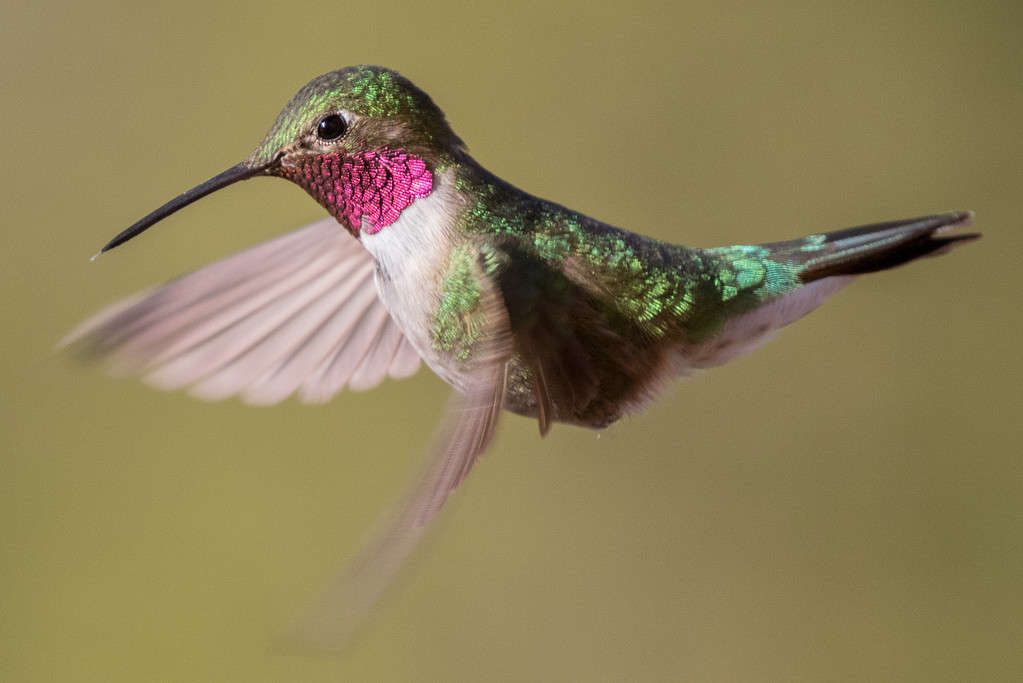
When it comes to hummingbirds, sunflowers don’t quite make the cut.
©David Kish/iStock via Getty Images
When we think of sunflowers, we envision their towering stalks adorned with magnificent golden blooms. These cheerful flowers seem to embody the essence of summer, attracting a myriad of pollinators with their abundant nectar and vibrant appearance. However, when it comes to hummingbirds, sunflowers don’t quite make the cut. Despite their visual appeal, sunflowers lack the nectar that hummingbirds crave. The long, tubular beaks of hummingbirds are perfectly adapted to sip nectar from deep-throated flowers, making sunflowers less appealing due to their flat, pollen-rich centers.
However, there are plenty of other flower options that will entice hummingbirds to visit your garden or balcony. These alternatives offer the perfect combination of visual allure and delectable nectar, making them irresistible to these dainty visitors. From trumpet-shaped blossoms to delicate clusters of vibrant petals, these flowers hold the key to attracting hummingbirds and witnessing their aerial acrobatics up close.
Note: While sunflowers may not be the top choice for hummingbirds, they remain an excellent option for attracting other pollinators, such as bees and butterflies. Their large, pollen-rich centers provide ample resources for these beneficial insects.
5 of the Best Flower Options for Hummingbirds
Hummingbirds are known for their preference for nectar-rich flowers, which provide them with the essential fuel they need for their high-energy lifestyle. If you’re looking to attract them to your garden or balcony, here are five flower options that are sure to captivate their attention:
1. Bee Balm (Monarda)
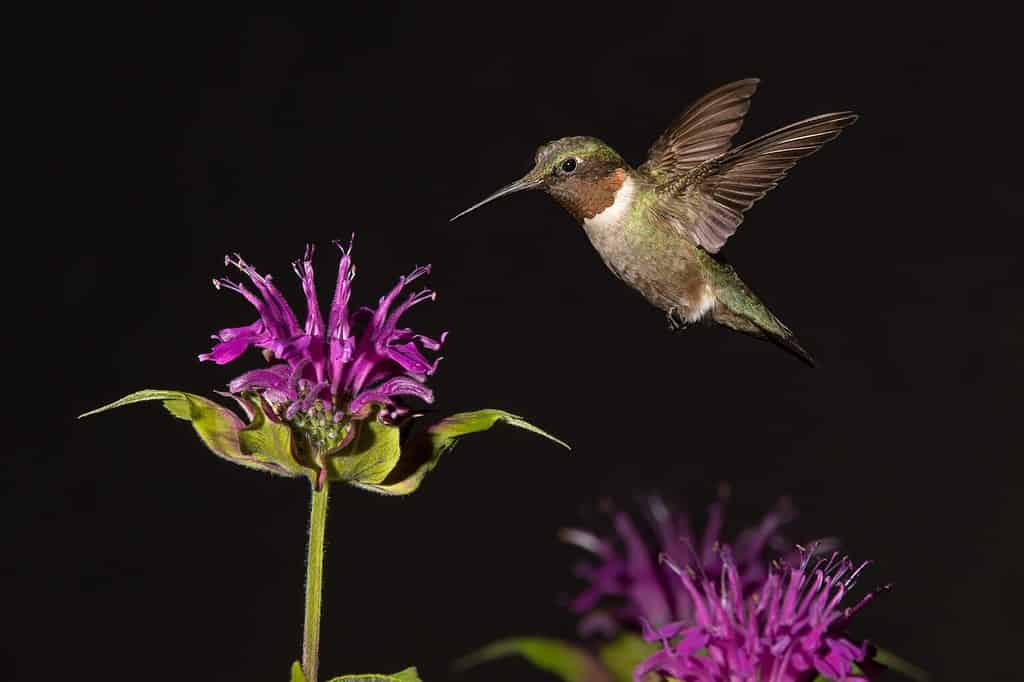
Ruby-throated hummingbirds love bee balm flowers.
©Matt Cuda/Shutterstock.com
With its vibrant, tubular blossoms, bee balm is a favorite among hummingbirds. Its rich nectar and showy flowers make it an irresistible choice. Here’s why these vibrant blooms hold such appeal for our feathered friends:
Rich Nectar Source: Bee Balm produces copious amounts of nectar, which is the primary energy source for hummingbirds. The tubular shape of the flower allows these tiny birds to easily access the nectar with their long, slender beaks and tongues.
Bright and Showy Blooms: Hummingbirds are naturally attracted to bright colors, and Bee Balm flowers certainly deliver in this aspect. With hues ranging from scarlet red and pink to purple and white, these eye-catching blossoms are irresistible to hummingbirds seeking nectar.
Tubular Flower Shape: The tubular shape of Bee Balm flowers is perfectly suited for hummingbird pollination. The long beaks and tongues of hummingbirds can reach deep into the flowers, ensuring efficient transfer of pollen from one plant to another.
Extended Blooming Period: Bee Balm flowers have an extended blooming period, often lasting for several weeks. This extended availability of nectar makes Bee Balm a reliable food source for hummingbirds throughout the season, attracting them to your garden or landscape.
How to Plant Bee Balm:
If you’re interested in attracting hummingbirds with Bee Balm, here are some guidelines for planting and caring for these delightful flowers:
Best Time of Year:
Bee Balm can be planted either in the spring or fall. In cooler climates, it is best to plant in spring to allow the plants to establish before winter. In warmer regions, fall planting is recommended to give the roots time to develop before the onset of hot weather.
Choosing the Right Location:
Bee Balm thrives in full sun to partial shade, so select a location that receives at least six hours of direct sunlight per day. Ensure the soil is well-drained, as Bee Balm prefers moist but not waterlogged conditions.
Planting Process:
Dig a hole that is slightly larger than the root ball of the plant. Place the plant in the hole, ensuring that the crown is at ground level. Backfill with soil, gently firming it around the roots. Water thoroughly after planting to help the plant establish.
Spacing:
Bee Balm plants should be spaced about 18 to 24 inches apart to allow for proper air circulation and prevent overcrowding.
Watering and Maintenance:
Keep the soil consistently moist but not waterlogged, especially during dry spells. Mulching around the plants can help retain moisture and suppress weeds. Regular deadheading of faded blooms will encourage prolonged flowering.
Zones:
Bee Balm is native to North America and is well-suited to a wide range of zones, typically from Zone 3 to Zone 9. However, specific varieties may have different hardiness ranges, so consult the plant’s label or a local gardening resource for the best options in your specific zone.
By providing the right conditions and care, you can create an inviting habitat for hummingbirds with Bee Balm. Enjoy the sight of these vibrant flowers and the joyful presence of hummingbirds in your garden.
2. Cardinal Flower (Lobelia cardinalis)
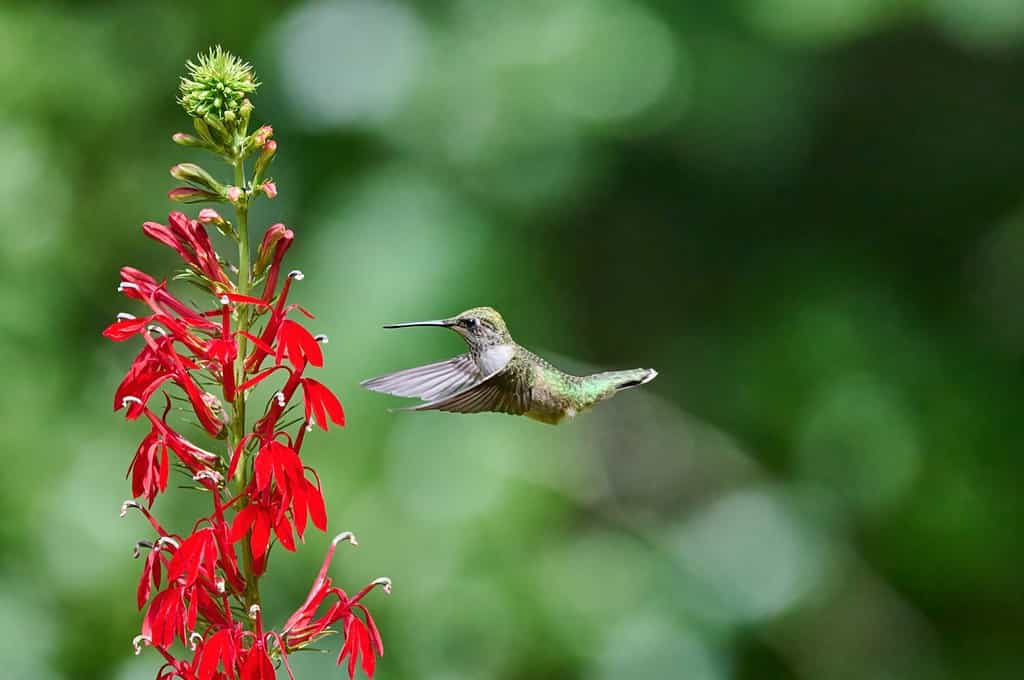
A juvenile male
ruby-throated hummingbird
enjoys feeding on cardinal flowers.
©Patrick Jennings/Shutterstock.com
Cardinal Flower, scientifically known as Lobelia cardinalis, is truly a favorite flower among hummingbirds. Let’s delve into the reasons why these stunning blooms hold such appeal for our winged companions:
Vibrant Red Color: Hummingbirds are naturally drawn to vibrant hues, and the Cardinal Flower’s intense, deep red color is particularly enticing. The bright red petals act as a beacon, signaling to hummingbirds that a rich nectar source awaits.
Tubular Shape: The tubular shape of Cardinal Flower’s blossoms is perfectly adapted for hummingbird pollination. The long beaks and tongues of hummingbirds can easily access the nectar hidden within the flower’s depths, making it an ideal match for their feeding habits.
Abundant Nectar: Cardinal Flowers produce ample amounts of sweet nectar, providing a valuable energy source for hummingbirds. The nectar-rich blooms serve as a vital fuel station, attracting these tiny birds and sustaining them during their migratory journeys or daily foraging activities.
Long Blooming Period: Cardinal Flowers have a lengthy blooming period, often lasting from mid-summer to early fall. This extended availability of nectar ensures a consistent food source for hummingbirds, making them frequent visitors to gardens where Cardinal Flowers are present.
How to Plant Cardinal Flower:
If you wish to attract hummingbirds with the enchanting Cardinal Flower, here are some guidelines for planting and caring for these captivating blooms:
Best Time of Year:
Cardinal Flowers are typically planted in the spring after the threat of frost has passed. This allows the plants to establish and acclimate to their surroundings before the arrival of hot summer temperatures.
Choosing the Right Location:
Cardinal Flowers thrive in moist, partially shaded areas. Select a location in your garden that receives morning sun and afternoon shade or dappled light. If your region experiences hot summers, providing afternoon shade is especially important to prevent the plants from drying out.
Soil Preparation:
Cardinal Flowers prefer moist, fertile soil. Before planting, amend the soil with organic matter such as compost to improve drainage and enrich the soil’s nutrients. This will provide a favorable growing environment for the plants.
Planting Process:
Dig a hole that is slightly larger than the root ball of the Cardinal Flower. Place the plant in the hole, ensuring that the crown is at ground level. Backfill with soil, gently firming it around the roots. Water thoroughly after planting to help the plant settle in.
Spacing:
Cardinal Flowers should be spaced around 12 to 18 inches apart, allowing enough room for the plants to spread and grow.
Watering and Maintenance:
Cardinal Flowers require consistent moisture, so water the plants regularly to keep the soil evenly moist. Mulching around the plants can help retain soil moisture and suppress weed growth. Deadhead spent blooms to encourage new flower production and extend the blooming period.
Zones:
Cardinal Flowers are native to North America and are typically suited to hardiness zones 3 to 9. However, specific varieties may have different hardiness ranges, so consult the plant’s label or a local gardening resource for the best options for your specific zone.
3. Penstemon (Beardtongue)
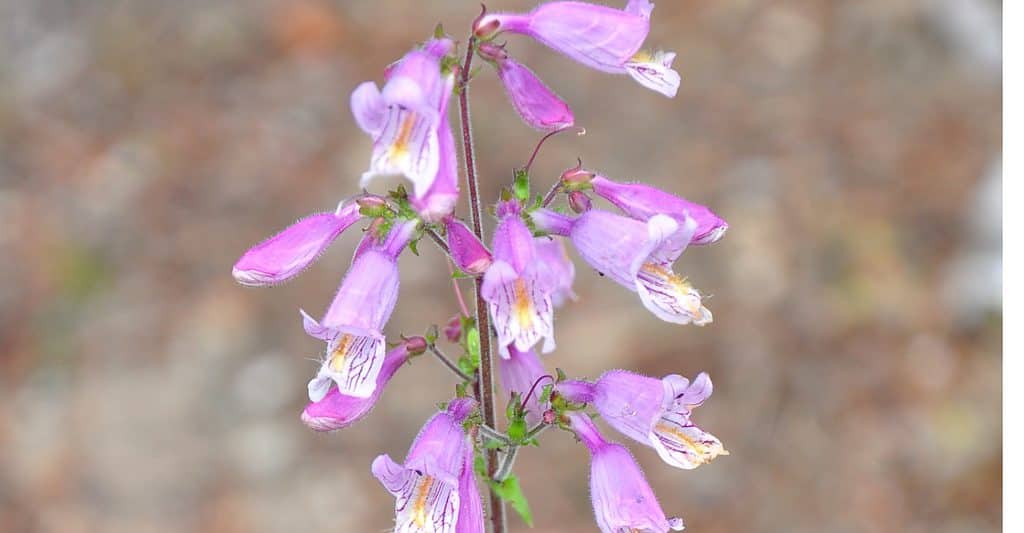
Hummingbirds love Penstemon (Beardtongue) flowers because of their tubular shape.
©iStock.com/rbiedermann
Penstemon, commonly known as Beardtongue, is a perennial flower that holds a special place in the hearts of hummingbirds. Let’s explore the reasons why these enchanting blooms are a favorite among our feathered friends:
Tubular Shape: The tubular shape of Penstemon flowers is perfectly suited to hummingbirds’ long, slender beaks and tongues. These unique blooms provide easy access to the nectar hidden within, making them an irresistible treat for hummingbirds.
Abundant Nectar: Penstemon flowers produce copious amounts of nectar, making them a valuable food source for hummingbirds. The high energy content of the nectar fuels these tiny birds during their long-distance migrations and daily activities.
Color Variety: Penstemon flowers come in a wide range of colors, including vibrant reds, pinks, purples, and blues. Hummingbirds are particularly attracted to these vivid, eye-catching hues. The colorful display acts as a beacon, guiding hummingbirds to the nectar-rich blossoms.
Extended Blooming Period: Many Penstemon species have a long blooming period, often spanning from late spring to early fall. This prolonged availability of nectar ensures a reliable food source for hummingbirds throughout the warm months, attracting them to gardens where Penstemon thrives.
How to Plant Penstemon:
To invite the delightful presence of hummingbirds into your garden with Penstemon (Beardtongue), here are some guidelines for planting and caring for these stunning flowers:
Best Time of Year:
Penstemon is typically planted in the spring or fall. The exact timing may vary depending on your location and the specific Penstemon variety you choose. In general, aim to plant in spring after the threat of frost has passed or in fall before the ground freezes.
Choosing the Right Location:
Penstemon thrives in full sun to partial shade. Select a location in your garden that receives at least six hours of direct sunlight per day. Ensure the soil is well-draining to prevent waterlogged conditions, as excessive moisture can be detrimental to Penstemon.
Soil Preparation:
Penstemon prefers well-draining soil with good fertility. Before planting, amend the soil with organic matter like compost to improve drainage and enrich the soil’s nutrient content. This will promote healthy root development and vigorous growth.
Planting Process:
Dig a hole that is slightly larger than the root ball of the Penstemon plant. Place the plant in the hole, ensuring that the crown is level with or slightly above the soil surface. Backfill with soil, gently firming it around the roots. Water thoroughly after planting to settle the soil and provide moisture to the roots.
Spacing:
Space Penstemon plants about 12 to 18 inches apart, allowing enough room for them to grow and spread. Consider the mature size of the specific Penstemon variety you are planting when determining the spacing.
Watering and Maintenance:
Water newly planted Penstemon regularly to keep the soil evenly moist, especially during dry spells. Once established, Penstemon is generally drought-tolerant, but it’s still beneficial to provide regular deep watering during prolonged dry periods. Deadhead faded flowers to encourage continuous blooming and remove any diseased or damaged foliage promptly.
Zones:
Penstemon is a diverse genus with various species and cultivars that thrive in different hardiness zones. While some Penstemon varieties are well-suited to a wide range of zones (e.g., zones 3 to 9), others may have more specific requirements. Research the specific Penstemon variety you are planting or consult local gardening resources to determine the best options for your particular zone.
By incorporating Penstemon into your garden, you can create a haven for hummingbirds while enjoying the beauty of these captivating flowers. Watch as these delightful creatures visit your garden, bringing life and vibrancy to your outdoor space.
4. Salvia (Sage)
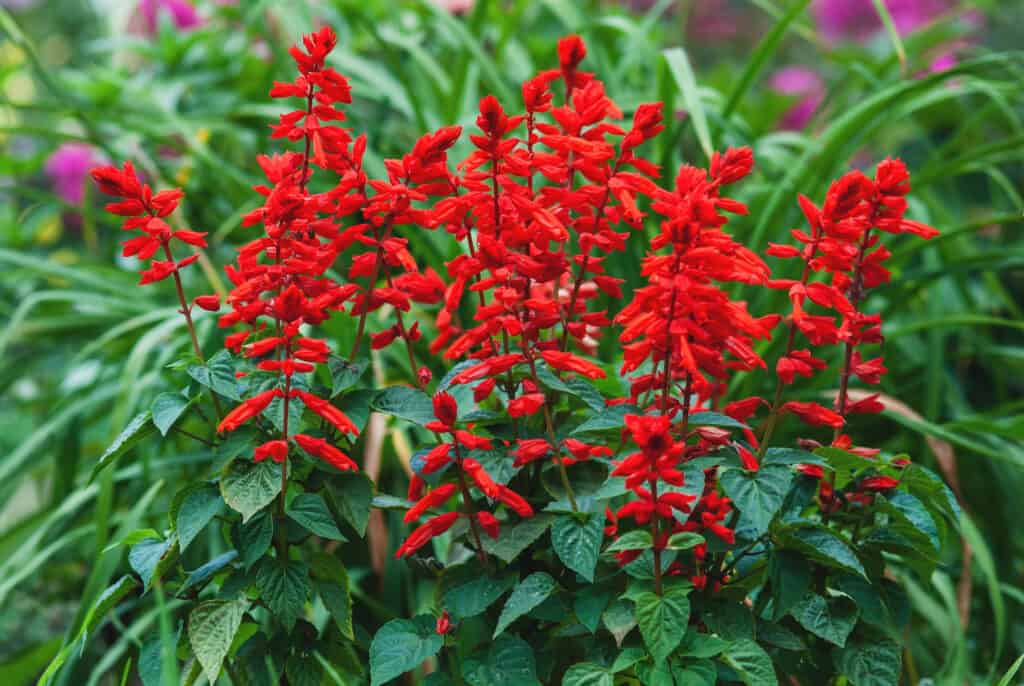
Scarlet sage salvia produces vibrant red flowers that hummingbirds and butterflies enjoy.
©iStock.com/Nadya So
Salvia, commonly known as Sage, is a beloved flower that holds a special allure for hummingbirds. Let’s dive into why these captivating blooms are a favorite among our feathered friends:
Tubular Shape: Salvia flowers exhibit a distinctive tubular shape, perfectly designed to accommodate hummingbirds’ long, slender beaks and tongues. The structure of these blossoms allows hummingbirds to easily access the nectar hidden within, making them an irresistible treat.
Abundant Nectar: Salvia plants produce generous amounts of nectar, making them a valuable food source for hummingbirds. The high sugar content of the nectar provides the energy hummingbirds need for their demanding flight patterns and fast metabolisms.
Brilliant Colors: Salvia flowers display a wide range of vibrant colors, including shades of red, purple, pink, and blue. Hummingbirds are highly attracted to these bold, eye-catching hues. The vividness of the flowers acts as a beacon, guiding hummingbirds to the nectar-rich blossoms.
Long Bloom Period: Many Salvia species have an extended bloom period, often lasting from early summer to late fall. This prolonged availability of nectar ensures a reliable food source for hummingbirds throughout the warm months, attracting them to gardens where Salvia thrives.
How to Plant Salvia:
Here are some guidelines for planting and caring for these enchanting Salvia flowers:
Best Time of Year:
Plant Salvia in the spring when the soil has warmed, and the threat of frost has passed. Depending on your location and the Salvia variety, you may also plant in early fall. Research the recommended planting time for your particular species or cultivar.
Choosing the Right Location:
Salvia thrives in full sun, requiring at least six hours of direct sunlight per day. Select a location in your garden that receives ample sunlight and offers well-draining soil. Salvia can tolerate a variety of soil types, but it thrives in moderately fertile, well-drained soil.
Soil Preparation:
Prior to planting, remove any weeds or debris. Amend the soil with organic matter to improve drainage, while promoting healthy root development and vigorous growth.
Planting Process:
Dig a hole slightly larger than the root ball. Place the plant in the hole, ensuring that the crown is level with the soil surface. Backfill the hole with soil, gently firming it around the roots. Water thoroughly.
Spacing:
Space Salvia plants approximately 12 to 18 inches apart. Consider the mature size of the specific Salvia variety when determining the spacing.
Watering and Maintenance:
Water newly planted Salvia regularly, especially during periods of drought. Once established, Salvia is relatively drought tolerant. Provide regular deep watering during prolonged dry spells. Remove spent flowers to encourage continuous blooming and prune the plants in early spring to maintain their shape and promote healthy growth.
Zones:
Salvia encompasses a diverse range of species and cultivars that thrive in various hardiness zones. While some Salvia varieties are adaptable to a wide range of zones (e.g., zones 4 to 9), others have more specific requirements. Research the specific Salvia variety you are planting or consult local gardening resources to determine the best options for your particular zone.
5. Trumpet Creeper (Campsis radicans)

Hummingbirds love red trumpet vines for many reasons including their fiery red color.
©iStock.com/Michel VIARD
Trumpet Creeper, scientifically known as Campsis radicans, is a beloved flower that holds a special place in the hearts of hummingbirds. Let’s explore why these vibrant blossoms are a favorite among our winged friends:
Distinctive Shape: Trumpet Creeper flowers feature a unique trumpet-shaped design, perfectly suited for hummingbirds. The long, tubular blossoms allow hummingbirds to access the abundant nectar hidden within. Their slender beaks and tongues can easily reach deep into the flower, satisfying their voracious appetite.
Rich Nectar Production: Trumpet Creeper plants produce copious amounts of nectar, making them a valuable food source for hummingbirds. The nectar contains a high concentration of sugar, providing the energy these tiny birds need for their constant and rapid wing beats.
Fiery Colors: Trumpet Creeper displays fiery hues, typically showcasing shades of orange and red. These vibrant colors act as a beacon, grabbing the attention of hummingbirds from afar. The visual allure of the flowers, combined with their enticing nectar, makes Trumpet Creeper an irresistible attraction for hummingbirds.
Long Blooming Period: Trumpet Creeper flowers have a prolonged blooming period, often lasting from mid-summer through early fall. This extended availability of nectar ensures a reliable food source for hummingbirds during their migratory journey or while nesting nearby. The reliable supply of nectar makes Trumpet Creeper an ideal choice for attracting hummingbirds to your garden.
How to Plant Trumpet Creeper:
Welcome the delightful presence of hummingbirds into your garden with Trumpet Creeper. Here are some guidelines for planting and caring for these captivating flowers:
Best Time of Year:
The ideal time to plant Trumpet Creeper is in the early spring when the soil has warmed and there is no longer a risk of frost. This allows the plant to establish its root system before the onset of hot summer weather. However, Trumpet Creeper is a hardy plant and can be successfully planted in early fall as well.
Choosing the Right Location:
Trumpet Creeper thrives in full sun to partial shade, requiring at least six hours of direct sunlight per day for optimal growth and blooming. Additionally, select a location that offers sturdy support for the vine to climb.
Soil Preparation:
Trumpet Creeper prefers well-draining soil rich in organic matter. Prior to planting, prepare the soil by removing any weeds or debris. Amend the soil with compost to improve its fertility and drainage.
Planting Process:
Dig a hole that is twice as wide and equally deep as the root ball of the plant. Place the plant in the hole, ensuring that the top of the root ball is level with the soil surface. Backfill the hole with soil, gently firming it around the roots. Water thoroughly to settle the soil and provide moisture to the plant.
Support Structure:
Trumpet Creeper is a vigorous climber that requires support to grow vertically. Install a trellis, arbor, or sturdy fence near the planting site for the vine to climb. Ensure that the support structure is durable and can withstand the weight and growth of the vine over time.
Watering and Maintenance:
Water newly planted Trumpet Creeper regularly to keep the soil evenly moist, especially during the first growing season. Once established, Trumpet Creeper is relatively drought-tolerant and requires less frequent watering. However, it’s still important to provide supplemental irrigation during prolonged dry spells. Prune the plant in early spring to remove any dead wood.
Zones:
Trumpet Creeper is adaptable to a wide range of hardiness zones, typically thriving in zones 4 to 9. However, it’s essential to research the specific Trumpet Creeper variety or consult with local gardening resources to ensure the best options for your particular zone.
5 Additional Flowers that Hummingbirds Love!
1. Lupine
The tall, spiky flowers of lupine come in a variety of colors and attract hummingbirds with their abundant nectar. These stunning blooms are a welcome sight in any hummingbird-friendly garden.
2. Foxglove (Digitalis)
With their tall spires of tubular flowers, foxgloves provide a feast for hummingbirds. These biennial plants are known for their enchanting blooms in shades of pink, purple, and white.
3. Agastache (Hyssop)
Agastache varieties, also known as hyssop, offer clusters of tubular flowers in vibrant colors. Their aromatic foliage and long-lasting blooms make them a favorite among hummingbirds.
4. Bleeding Heart (Dicentra)
The unique heart-shaped flowers of bleeding hearts not only add a touch of whimsy to your garden but also attract hummingbirds. Their delicate blooms are a delight to behold.
5. Zinnia
Zinnias are not only a favorite among gardeners but also among hummingbirds. These cheerful, daisy-like flowers offer a generous supply of nectar and come in a wide range of colors.
In Conclusion
By incorporating these flower options into your garden, you can create an enticing haven for hummingbirds throughout the season. Remember to provide a variety of flower shapes, colors, and bloom times to ensure a continuous supply of nectar for these remarkable creatures!
The photo featured at the top of this post is © Patrick Jennings/Shutterstock.com
Thank you for reading! Have some feedback for us? Contact the AZ Animals editorial team.







